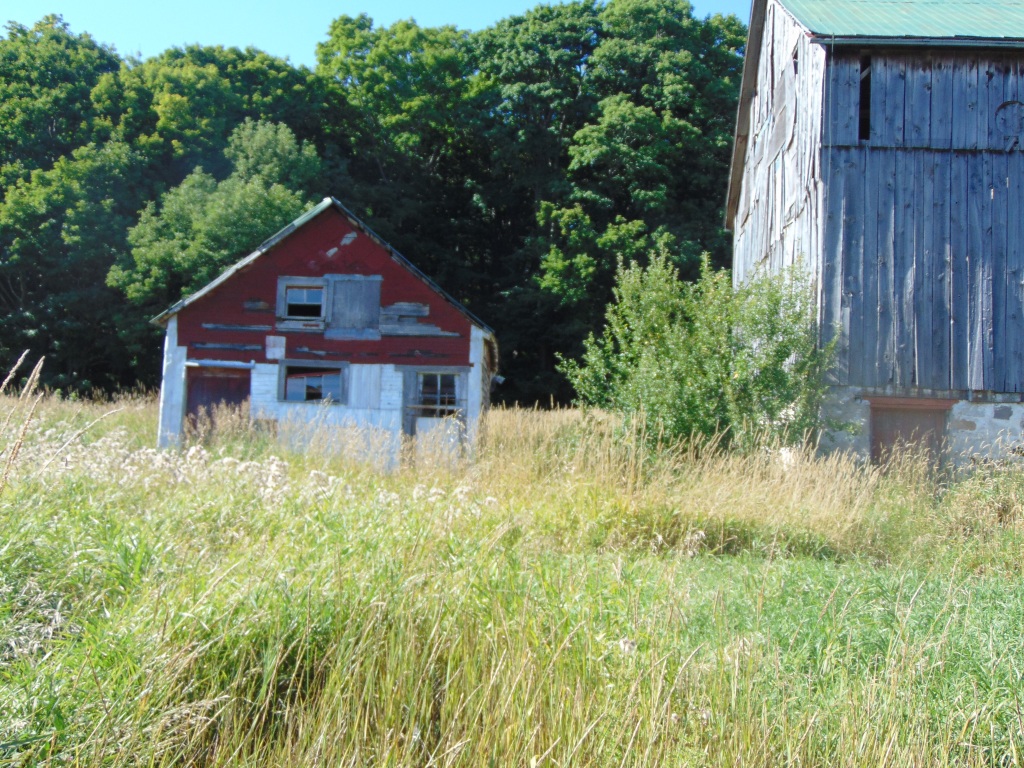 In the spring of 2022, I finally put two and two together and decided the time had come to work up the ground in part of the old barnyard to see if that might be a better place to grow vegetables.
In the spring of 2022, I finally put two and two together and decided the time had come to work up the ground in part of the old barnyard to see if that might be a better place to grow vegetables.
My two existing garden plots closer to the house have poor drainage and low fertility issues that seem to aggravate the already challenging characteristics of the heavy clay loam soil. A few days without rain and it turns into the dreaded, unworkable hardpan. Not ideal for gardening, to say the least. The use of lots of straw mulch to help keep moisture in the soil, and to be worked into it after harvest, hasn’t seemed to seem to help much in the seven years I’ve been gardening here.
Meanwhile, the barnyard sloped gently and naturally toward my small portion of the old hay field. (The greater portion, stretching west between the forest on either side is now part of the Hope Bay Nature Reserve. A long story that: see ‘The Day Dow Came to Hope Ness’ in this blog.)
For 100-plus years the barnyard had been fertilized by livestock, beginning in the 1880s as a pioneer homestead, mixed farm. The barn was set up for beef cattle; first, oxen, then horses, were used to till the soil. The first temporary home for the farm family was built near the barn some time soon after John Heath bought the 100-acre lot in 1880 for $100. It eventually became a pig barn after the permanent house was built in 1895.

So, it was a given: the barnyard soil was bound to be fertile.
After I had the 2022 season garden planted by the late spring, I first broke the south portion of the barnyard ground with the 1950-vintage Ferguson cultivator. The 1930’s vintage drag cultivator worked best for the final passes. As a cover crop I scattered 50 pounds of buckwheat in early June when the risk of frost had passed. Despite its name, Buckwheat is not a grain, though it is often used like cereal grains. I use it along with wheat flour in my favorite muffin recipe; and I use it as my favorite cover crop because it grows high and dense enough to shade out and discourage the growth of twitch grass. Still a bane of an organic farmer’s existence, twitch grass, also known around the world by other names, such as couch grass in the U.K., is not indigenous to North America. It’s arrival sometime in the early 20th Century quickly spread and became a big problem for farmers and other plants because, among other attributes, it secretes an enzyme that discourages the growth of other plants. It’s no doubt one of the big reasons why Monsanto invented the now much-used herbicide Roundup.
The barnyard was overrun with twitch grass. Two, successive crops of buckwheat, the first mowed down to re-seed itself, is best to discourage twitch grass; but I wanted to plant a garden in the spring of 2023, so I made a point of cultivating before the first frost in the fall of 2022, and in the early spring of 2023 to expose the dense twitch grass root-network to killing cold. I used my 40-year-old TroyBilt rototiller sparingly (two passes – one shallow, one deeper – to prepare the soil for the planting of ‘the three sisters,’ rows of beans, pumpkin, butternut squash, and sweet corn.
Organic Cinderella pumpkin seed was acquired locally, from Franken Farms Seed. Untreated bean, butternut squash, and one variety of sweet corn came from Willian Dam Seeds. My old standby, early peaches and cream sweet corn, also untreated, and not bioengineered, came from Ontario Seed Company (OSC).
I started planting May 26, and finished in the first week of June. But, as Ontario farmers and gardeners know, the 2023 season began with a month-long drought in late May and early June. I hand-watered my three garden plots daily from a dug well. There’s nothing like rain; but I managed to keep the transplanted, started indoors pumpkin and squash alive; However, I feared the untreated corn seed in the new barnyard garden was a loss because the soil temperature was too low for germination; but, to my surprise, three planting of corn came up, at a rate of about 60 percent after the rain. Still, it was a joyful occasion.
And within a couple of weeks, the new garden in the old barnyard was flourishing. Indeed, I don’t think I’ve ever seen such dynamic growth, especially of the squash family, pumpkins (Cinderella) and butternut squash. Meanwhile, the sweet corn is growing so well I’m not going to bother with the usual side dressing of fertilizer for this heavy feeder.
I also hope in some way to honor those who came before on this farm, and worked so hard, for so little. From the barnyard garden I look out across that long, hay field reaching out to the west in the darkening sky. Soom enough the forest on either side will close in again, and their being here, most of them for less than 100 years, may be remembered only as a brief episode. I feel their tears in the soil as, on my knees, I pull out weeds by hand; but I see little of the twitch grass that drove men mad remains.
I see them smile and hear them say, “well now, isn’t that something. Good for you, young fellow.”



























